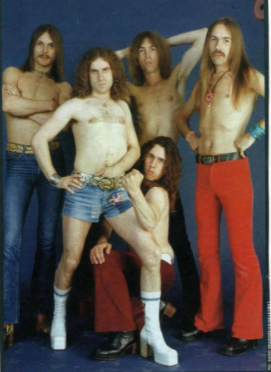-
Posts
525 -
Joined
-
Last visited
Content Type
Forums
Events
Gallery
Posts posted by Subway
-
-
Movie Night- To Live & Die in LA
-
 4
4
-
-
Angus (AC/DC) covers George Benson's "On Broadway"

-
 3
3
-
 1
1
-
 1
1
-
-
Chaka Chaka Chaka Khan !
-
 2
2
-
-
Salt in My Tears / Cruel to be Kind
-
 2
2
-
 1
1
-
-
".......transistor power amplifier for the low pass and a tube for the mid/high range." "If so where are the acoustic advantages ?"
Following is a transcript of the relevant part of Bob Carver's [video interview] (https://www.youtube.com/watch?v=LQ9USqpclWc&feature=youtu.be&t=50m2s😞
Host: What are your thoughts on solid state amplification vs tube amplification?
Bob Carver: Ahh...I grew up with tubes. I loove vacuum tubes. They glow in the dark. I have a wonderful warm feeling when I listen to my music with vacuum tubes. Again, go back to the stereophile challenge. You can see that a vacuum amplifier and a solid state amplifier can be made to sound virtually indistinguishable. That's the reality of it. However, when I listen to vacuum tube amplifiers, I go...there is a magic here that I adore and love and not about to give it up. So I have both amplifiers in my listening room. I have vacuum tube amplifers. I have latest solid state amplifiers. And they both sound stunning to me. I'm very very happy with both of them.
Host: Can you describe at all what the difference might be if they measure virtually identically as you have talked about it in the amp challenge. What is that magic?
Bob Carver: Here's one of the magic. If we listen to a vacuum tube amplifier, when a vacuum tube amplifier produces a signal it makes the loudspeaker move. The loudspeaker sends sound waves into the room. Sound waves bounce off the wall and they come back to the loudspeaker. Like a microphone they make the loudspeaker move. The loudspeaker makes a little voltage just like the microphone would. That voltage is fed back around the amplifier's feedback loop back to its input. All amplifiers have two inputs. One is the audio signal that comes from the outside world and there is a audio signal which is the feedback signal. Both of these signals are the same. They are the same amplitude, same frequency response, everything. What happens on a vacuum tube amplifier, the amplifier makes another sound that's related to the sound that it heard. In other words, the amplifier is able to listen to the room because it's hearing reverberations, echoes, time delays, all the components associated with the venue. So the loudspeaker speaks and the room speaks back to the loudspeaker. The amplifier hears it by the signal going back to the feedback loop and out it comes again.
Host: It is delayed by some of the time..right?
Bob Carver: It's not delayed by much. The real delay is the acoustic delay (Host: exactly...that's what I'm talking about). Yes...it's delayed..exactly, exactly. That delay makes it sound spacious and big to our brain system. We love sounds that have ambiance and echoes and stuff like that.
Host: But don't solid state amps do the same thing?
Bob Carver: No, for a solid state amplifier, it's output impedance is so low that when it tells the speaker to move, the speaker sends the wave out which bounces off the walls and comes back. A solid state amplifier will not allow the speaker to move in response as in the sound wave coming back and hitting it.
Host: How can the amplifier tell the speaker how to move?
Bob Carver: The amplifier tell the speaker how to move initially. Then the amplifier shorts the speaker out and the speaker cannot move on the back wave meaning the amp is said to have a very low output impedance, so the speaker can't move. That's all it is...it shorts the speaker out basically.
Host: So the vacuum tube amp has a somewhat higher output impedance.
Bob Carver: Exactly and that higher output impedance is one of the things we hear when we listen to a vacuum tube amplifier. It's one of the things that make a vacuum tube amplifier sound so enjoyable, so nice and so spacious.
-
 5
5
-
-
Mass Psychosis / The Specials - The Lunatics (have taken over the asylum) - Live at The Novo Los Angeles
-
 2
2
-
 2
2
-
-
The Girl From Ipanema / Bossa Nova Medley
-
 6
6
-
 1
1
-
-
7 minutes ago, MicroMara said:
Documentary on Keys- pretty good. (Micro sporting "new" avatar? nice!)

-
 3
3
-
-
Pharma, grocery, health care, tech stocks, real estate, precious metals, carbon futures & more speakers- good to go! 😉
Buffett's 3 Best Rules For Stock Investing (investopedia.com)
-
Baby I Love Your Way/Freebird Cover (two covers in one with outstanding video)
-
For what it's worth:
Federal Reserve Chief Announces Feds ‘Exploring’ Creation of Government Cryptocurrency
JUST IN - $600 million stolen in Ethereum and other cryptocurrencies after hackers allegedly breached the blockchain-based, decentralized finance platform Poly Network (Forbes)
The U.S. government has seized cryptocurrencies worth $1.2 billion so far this year, according to an Internal Revenue Service director. This is a significant increase from $137 million in crypto seized the previous year.
-
 1
1
-
-
58 minutes ago, Dave1291 said:
I can neither confirm or deny I ever saw that show! lol
C'mon Man! Full Range manned-up. You know you had the 45 and poster too!

-
 3
3
-
-
H.R. Pufnstuf 1969 Opening Theme Song
Downtown Atlanta’s Lost Psychedelic Theme Park - Atlas Obscura - think I visited in the 70's
-
All his dreams pass before his eyes,....................a curiosity
-
 4
4
-
 1
1
-
-
SHOW ME HOW TO LIVE - I CAN'T GO FOR THAT
-
 2
2
-
 2
2
-
-
Stick With Mono
-
 3
3
-
 1
1
-
-
4 hours ago, oldtimer said:
As we know it.
And I feel fine.
-
 4
4
-
 1
1
-
-
2 hours ago, MicroMara said:
About to set sail- hence the flag. Shakedown cruise!!!!!!
SCORPIONS ready to swim.

-
 4
4
-
 2
2
-
-
What's Going On ? (see above)
-
 2
2
-
 1
1
-
-
FOR THE LOVE OF MONEY----- "Dollar Bills Y'all"----- ripping bass line
-
 1
1
-
-
In the eye of the congestion storm: Q&A with Port of LA’s Gene Seroka (freightwaves.com)
Southern California gateway still clogged as wave of peak-season cargo looms

-
Chinese Democracy - Connection - Bahama Mama - Jamaica Jerk Off - Pirates of the Caribbean
-
 3
3
-
-
Blood In The Streets - The Doors
-
 1
1
-
 2
2
-
-
1 hour ago, MicroMara said:
@Subway Belated first time welcome to the KC. You catched my eye already for weeks through your avatar identity finding game.

Every time I'm online you have changed your avatar.

There were very nice ones, but am now very happy with your Avatar for more than 24 hours of you were chosen. .
It suits you perfectly.

And The Cradle Will Rock - Germany
-
 4
4
-












YouTube Spinning
in Lounge
Posted